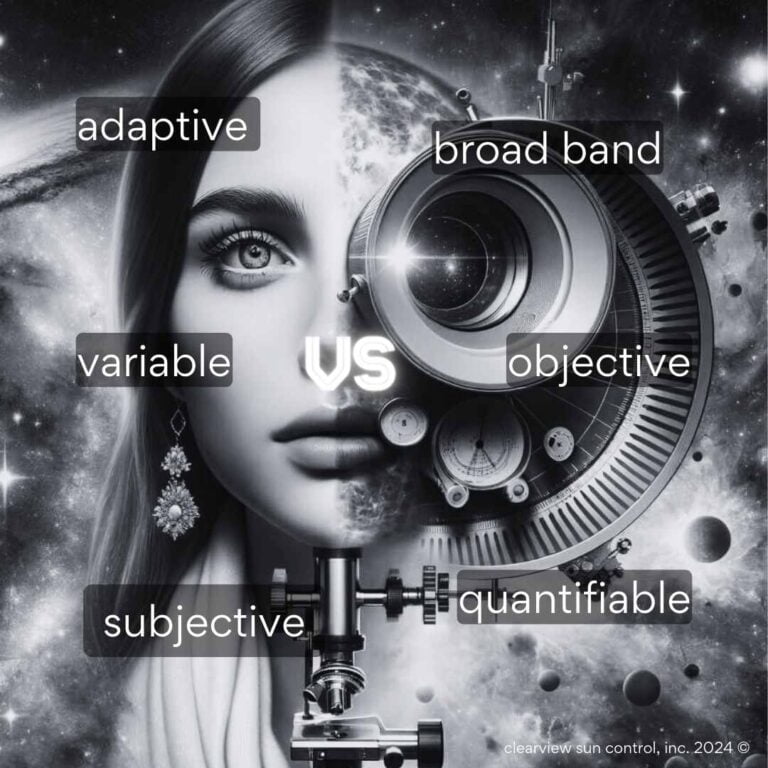Choosing the right shade of solar tint for your residential or commercial project is usually the #1 factor to consider so in researching this phenomenon of what we perceive as light is an exciting and refreshing perspective we think you should seriously consider.
In our quest to understand the world around us, both the human eye and technological instruments like spectrophotometers play crucial roles. While they might seem to perform similar functions, they are fundamentally different in how they perceive light. Let’s delve into these differences and for this blog since we are in the UV window film business we are concentrating on the visible light spectrum aspect, the only spectrum of the electromagnetic solar spectrum we can see with our bare eyes.
The Human Eye: A Natural Wonder
Adaptive Vision:
The human eye can adapt to different light conditions, allowing us to see in various environments, from the dim moonlight to the bright sunshine. When exposed to different levels of light, our pupils adjust, and our perception of brightness changes over time. This adaptation can make it challenging to accurately judge changes in visible light transmission immediately after the installation of solar film.
Variable & Subjective Interpretation:
The human eye and spectrophotometers differ in how they perceive and measure visible light transmission. It is influenced by factors such as age, eye health, and personal preferences. The human eye’s perception of visible light is subjective. It can vary from person to person and can be influenced by factors such as lighting conditions, adaptation, and individual sensitivity to light. Human perception is not consistent and can be influenced by personal experiences and preferences.
Spectrophotometers: Precision Instruments
Objective Measurement:
Unlike the human eye, a spectrophotometer measures the intensity of wavelengths of light precisely. It provides an objective measurement of light and color, unaffected by human biases or perception.
Broad Range Sensitivity:
Spectrophotometers can detect a broader range of wavelengths than the human eye, including those outside the visible spectrum like ultraviolet and infrared.
Quantifiable Data:
These instruments provide quantifiable data that can be used for scientific analysis, ensuring consistency and repeatability in measurements. They measure the exact amount of light at different wavelengths that passes through a material, such as solar window film. Spectrophotometers provide objective and consistent measurements of visible light transmission.

Reality vs Window Film VLT Spec’s…
Human Eye Perception:
Our eyes are incredibly adaptable and have the ability to adjust to varying light conditions. When you first install solar film on glass, the visible light coming through may appear much lighter than expected because our eyes quickly adapt to the new lighting conditions. This means that even though the film is effectively reducing the amount of incoming light, your eyes perceive the space as brighter due to their ability to adapt.
Official Specifications vs. Human Perception:
Official specifications for solar films are typically based on objective measurements using spectrophotometers. These instruments provide consistent and accurate readings of how much light is being blocked or allowed through the film. However, they don’t take into account the subjective perception of light by the human eye.
Subjectivity of Perception:
Human perception of light can vary from person to person. Some individuals may perceive a room as much brighter with a certain shade of solar film compared to others. It can also depend on factors such as the time of day, the angle of the sun, and the surrounding environment.
Conclusion and Regret:
People may sometimes come to the conclusion that they could have chosen a darker shade of window film because they initially expected a more noticeable reduction in brightness based on the official specifications. They may regret their choice, only to realize for the same cost a product more effective in reducing fade, glare and heat would have been a better solution.
Putting it all together
One of our trusted manufacturers, Madico Inc. provides some examples of what these perceived values are. We can provide you with their official paper during your free consultation.
quick reminder: VLT = visible light transmission, this is the % of light being passed through not blocked.
spec = 60% vlt – we perceive 82% vlt
spec = 33% vlt – we perceive 68% vlt
spec = 18% vlt – we perceive 55% vlt
(data provided by Madico Inc. Technical paper S955043 1/12:)
Lower VLT Films = Better Performance:
A solar film that allows less visible light to enter will ‘generally’ perform better in many ways and correlates strongly to improved fade reduction, glare and heat reduction. There are some outliers such as our premium line of films but in most cases this is the rule-of-thumb.
Balancing Comfort and Protection:
Now you have more tools to help you strike a balance between preserving your view and reducing fading risk or other sun control issues. By considering VLT values and their impact on ‘perceived brightness’ you can choose solar films with moderate VLT values that provides superior performance while still allowing sufficient natural light and visibility.
Clearview Sun Control, Inc. is located in Redondo Beach, CA., we have been serving Long Beach, Manhattan Beach, South Torrance, Rancho Palos Verdes, Rolling Hills and surrounding areas within a 100 mile radius since 2001, CA lic #774678.